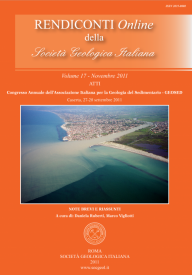
The geological map n. 465 "Isola di Procida" (scale 1:50.000): an example of cartographic representation of marine areas in the Campania offshore
Aiello G. (*), D'Argenio B. (*), Marsella E. (*) & Conforti A. (*)
(*) Istituto per l'Ambiente Marino Costiero (IAMC), CNR, Calata Porta di Massa, Porto di Napoli, 80133 Napoli. E-mail: gemma.aiello@iamc.cnr.it; b.dargenio@iamc.cnr.it; ennio.marsella@iamc.cnr.it; alessandro.conforti@iamc.cnr.it
Volume: 17/2011
Pages: 3-6
Abstract
In the last decade the Geomare Sud Institute, National Research Council of Italy, now Institute of Coastal Marine Environment has carried out a marine geological survey of the Campania Region (CARG Project) for the construction of experimental geological maps committed from the National Geological Survey of Italy, now APAT (Agency for the Protection of the Environment and the Technical Services). The start-up of the project has been dedicated to the data acquisition for the marine sector of the geological maps n. 465 "Procida", n. 466 "Sorrento", n. 467 "Salerno" and the maps n. 484 "Capri" and n. 485 "Termini" within the 200 m isobath. Several geological and geophysical surveys of the continental shelf and slope of the Naples Bay have been carried out to realize the geological map n. 465 "Procida", including the most part of the gulf. A high-resolution Multibeam bathymetry of the Naples Bay coupled with Sidescan Sonar profiles allowed for the construction of a marine DEM, giving a detailed image of the morpho-structures at the sea bottom and realization of geological maps, varying in scale from 1:50.000 to 1:10.000. The stratigraphic architecture of the Naples Bay has been controlled by volcano-tectonic processes, preventing a simple application of seismic and sequence stratigraphic techniques, strongly recommended by the guidelines for the redaction of marine geologic cartography. The realized cartographic approach, however experimental, is based on the recognition of laterally coeval depositional systems, representing portions of systems tracts of the Late Quaternary Depositional Sequence (SDTQ). The marine geological map shows the distribution of several lithostratigraphic units cropping out at the sea bottom and of the main morphological lineaments, based on the CARG guidelines for the realization of marine cartography. In this way, we tried to realize an integration between classical stratigraphic approach, sequence stratigraphic approach and characterization of present-day and recent depositional systems.
Keywords
Get Full Text